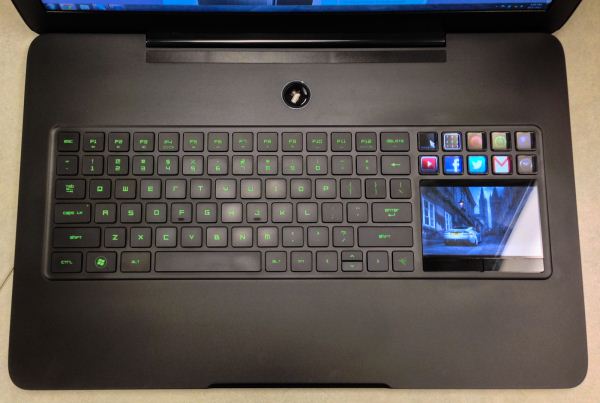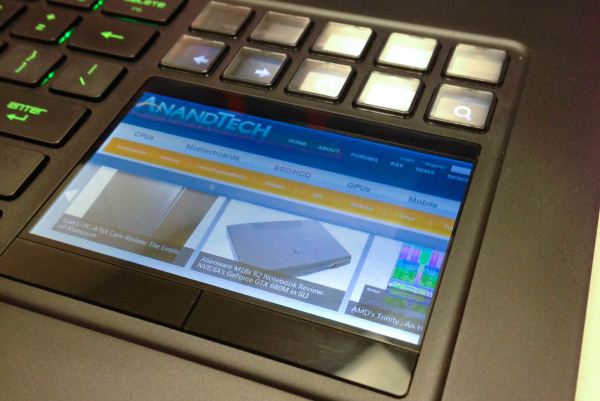The New Razer Blade: Thoroughly Reviewed
by Vivek Gowri on October 3, 2012 5:40 PM ESTRazer Blade (late 2012) - Switchblade UI
Easily the most significant issue I had with the original Blade’s user experience while I had it was the usability of the Switchblade UI system, and other than the overall system value quotient, it was the biggest reason I could point to for not recommending a Blade purchase. By “usability of the Switchblade UI”, I’m not even saying that it was hard to use, just that it was never working reliably enough for me to use on a day-to-day basis. Synapse, Razer’s cloud-driven device settings manager, would crash with regularity, and the entire system had issues coming out of standby mode.
The good thing here is that the Synaptics drivers were pretty solid, so you could still use the touchpad part of it even when Synapse and Switchblade were long gone. Of course, there were also the occasional times when Switchblade would nuke itself completely (to use the technical term for it)—the LCD buttons would turn white and the touch panel would become unresponsive, necessitating a full system reboot. Through my three months with the original Blade, I probably spent two-thirds of my time with the Switchblade part of things not working. I didn’t care most of the time as long as the multitouch trackpad was working, but it was definitely a significant problem that needed to be addressed going forward.
I wasn’t the only one who noticed this, as Razer took a beating in various online notebook owner forums. Thankfully, the company was very proactive about pushing new updates and new content to Switchblade. Based on my interactions with the new Blade and also the DeathStalker Ultimate keyboard over the last month, it’s definitely a night and day difference in terms of stability and usability.
This is a very, very good thing. So is the new SDK that was released by Razer, something that will become an asset as more Switchblade devices hit the market. There are a couple of new applications, including a game timer and a screenshot app. Razer is also working with a number of game developers to add support for a number of popular titles, including CounterStrike, CS:Source, CS:GO, Team Fortress 2, Battlefield 3, and Star Wars: Knights of the Old Republic at present, with more games currently in validation. And call me shallow, but I find the new ability to set your own wallpaper for the LCD touchpad simply awesome.
But here’s my deal. Even with all of the improvements being made to Switchblade, it’s still a cool concept with only a very specific usage model. Even then, a lot of the experiences are subpar—the browser is still Mobile IE 7 running on an embedded Windows NT 5.1 kernel, and it absolutely pales in comparison to basically any modern smartphone browsing experience. The Gmail, YouTube, Facebook, and Twitter applications are just the mobile IE 7 experiences, which makes them generally painful to use, but it's also worth noting that YouTube videos played back at a very low frame rate, 20 frames per second or less. Any iPhone or iPod touch (going all the way back to the ARM11-based originals from 2007) will top that. So will the Zune HD or any credible Android/Windows Phone/WebOS device made in the last three years.
It’s a blatant issue—it’s far easier and more convenient to just pull out a smartphone or an iPod to check the internet, email, or social networks. The gaming functions are nice enough, as is the screenshot application, and I suspect we’ll see Switchblade get more useful as developers come aboard and more games-specific applications are launched. The game developers can do some pretty innovative things with Switchblade; we were shown a demo of the Firefall application that allowed you to use the touchscreen as either a virtual analog controller or showed the environment map, for example.
Switchblade clearly has the potential to enhance gaming experiences, but it’s just as clear that it needs a lot of work in other areas. I enjoy the idea of having a touchscreen input, along with the configurable shortcut keys at the top. The placement, too, is very convenient and is much more natural to use than a traditionally placed touchpad once you get used to it. But with such outdated software experiences powering the core web-based functions of Switchblade, it’s sadly going to remain a novel but not particularly functional sideshow outside of its uses in the gaming realm.
If you look solely at the keyboard and mouse, things look pretty solid. The touchscreen trackpad, like I said above, is great to use; Synaptic’s multitouch drivers are seamless and offer a wide range of gesture support. Razer has improved the touchpad buttons to give much more positive feedback on clicks—there’s less of a cheap plastic sound when you actuate them. The keyboard is almost untouched, meaning fully anti-ghosted and individually backlit keys that have zero flex, though the key travel itself is a bit shallow. Razer has backlit the secondary functions (brightness, volume, etc), which has made using them in the dark significantly more convenient. I still take issue to the layout (seriously, there’s little to no reason for the Fn key to be on the right side of the spacebar) but you get used to it quickly enough as long as you aren’t switching from notebook to notebook.













59 Comments
View All Comments
davos555 - Thursday, October 4, 2012 - link
As one of the 10% of left handed people, I couldn't use this. I much prefer the trackpad in the middle, as I draw with my left hand (use my finger) and click with the right hand. I couldn't use it comfortably where it is on this.Old_Fogie_Late_Bloomer - Thursday, October 4, 2012 - link
And I'm a righty, but I tend to mouse lefty when I'm not gaming to even the wear and tear on my wrists. Heck, at work I use my left hand almost exclusively. That trackpad just isn't a viable solution for me. :-\adityav - Thursday, October 4, 2012 - link
Its a problem for left handers like me. I am willing to buy this but that trackpad position won't work for me.tipoo - Wednesday, October 3, 2012 - link
As we all know, that was the first and only black laptop before this.Kidding, but I don't see much similarity beside that, I don't have to repeat that the chicklet keyboard isn't unique to the MB either.
tbutler - Thursday, October 4, 2012 - link
The 'form over function' slam is really irritating. This is a *laptop.* The entire point is being able to tote it around. (If desktop space is limited, an AIO or SFF will still give you more bang for the buck than a laptop if you're not going to be carrying it around.)Therefore, size and weight are FUNCTIONAL issues. Not fashion. Size/weight vs performance is still a valid discussion, but it's a choice between two different kinds of functionality - not form over function.
By the same token, case materials are a functional issue. Logo stickers, sculpted flanges, all that crap is form - but a solid metal build vs the kind of cheap plastic described in yesterday's Clevo review will definitely affect the laptop's operation. Again, goes back to portability; a well-built case is going to hold up better under the wear and tear portable systems experience, and do a better job of protecting the internal components.
Octopilion - Friday, October 5, 2012 - link
Your argument is pointless mac book pros don't even have these specs and cost about the same price and there's a ton of sheep buying themCaptainDoug - Wednesday, October 3, 2012 - link
I just wish that there was some way to just install the OS on the Msata and then have my hard drive for anything else. I really don't get caching. I get it, but it's lame. For me, this second revision makes it a much more serious contender but I think I'd still choose the HP ENVY 17t-3200 series. You get a msata port + 2x2.5" drives. The 7850M is only slightly worse than the 660M and it has amazing sound. True it is 1.28" thick instead of .88" but it's also $1000 less and comes with a blu-ray drive. I totally understand why someone would want this though. I'm not bashing on this laptop at all, it's just not everything i want. If the Razer Blade R2 was somehow user upgradeable/configurable, that's another story. 16GB of ram, and replacable hard drives isn't too much to ask is it? That being said, if I had money to blow, I'd get this for the coolness factor over the HP Envy.JarredWalton - Wednesday, October 3, 2012 - link
I wish Razer would offer a build with a 256GB mSATA SSD with the OS and apps, and then provide a 750GB/1TB HDD for mass storage. (Or just leave the 2.5" bay open and let users add something on their own if they need more storage.) I'd also be far happier with a traditional touchpad and save the money that it costs to put the Switchblade into the laptop.VivekGowri - Wednesday, October 3, 2012 - link
If you're willing to get intimate with the DataPlex software, you can theoretically uninstall it and set up the mSATA SSD as the boot/application drive. I'm not sure why Razer didn't go that route with it, I guess it was just cheaper for them to give a smaller caching drive?s2kpacifist - Wednesday, October 3, 2012 - link
This looks like a great second entry into the gaming laptop market, but I really wish if they had a 15" flavor of the Blade, sans Switchblade. Hell, maybe even a 17" version without the switchblade touchpad. The reason? Any serious gamer will undoubtedly be using high dpi mouse for the game they are playing. The whole concept of the Switchblade is innovative, but it's probably adding some unnecessary cost and features most gamers can do without. The buttons are okay, but until Razer can get the trackpad screen to out-do what most modern smartphones can do in terms of responsiveness, browsing experience, and dpi/resolution, I think Razer can do much better without Switchblade .